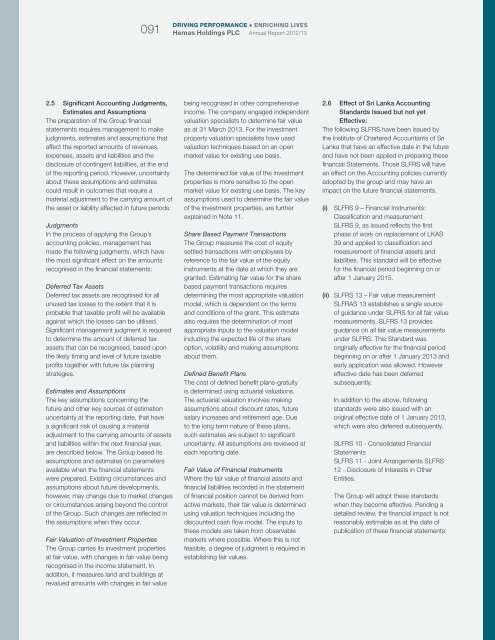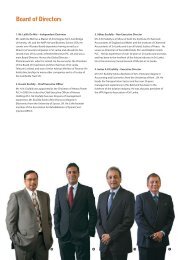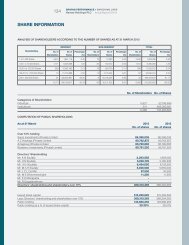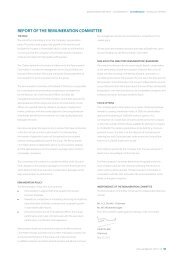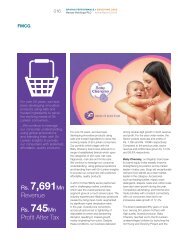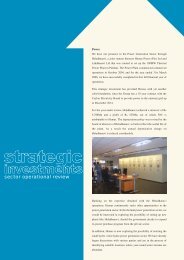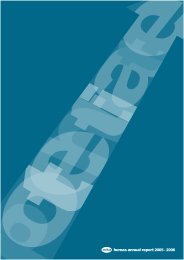DRIVING PERFORMANCE ● ENRICHING LIVES090 <strong>Hemas</strong> <strong>Holdings</strong> PLC Annual Report 2012/13NOTES TO THE FINANCIAL STATEMENTS2.4 First time adoption of SLFRS-CompanyNotes to the reconciliation of equity as at1 April 2011 and 31 March 2012 and totalcomprehensive income for the year ended 31March 2012.A. Transfer from PPE to IntangibleAssetsAll computer systems are currentlycategorised in property, plant and equipment.However, as per LKAS 38, computersystems that are not integral to operatethe hardware should be recognised as aseparate intangible asset and should beamortised. Therefore, as at 1 April 2011a cost of Rs.20.5Mn and an accumulateddepreciation of Rs.17.5Mn recorded inproperty plant and equipment has beentransferred to intangible assets andaccumulated amortisation respectively. Acost of Rs.0.3Mn and depreciation expenseof Rs.2.0Mn has been transferred fromproperty plant and equipment to Intangibleassets and amortisation expense respectivelyfor the year ended 31 March 2012.B. Impairment of Trade ReceivablesAccording to the current practice, theprovision for impairment of receivablesconsists of both a specific amount forincurred losses and a general amount forexpected future losses. SLFRS/LKAS donot permit recognition of impairment forexpected future losses. Hence this amount(Rs.0.5Mn) has been eliminated againstretained earnings as at 1 April 2011. Adebtor or a group of debtors are deemed tobe impaired if, and only if, there is objectiveevidence of impairment as a result of one ormore events that has occurred after the initialrecognition of the debtor (an incurred ‘lossevent’) and that loss event has an impact onthe estimated future cash flows of the debtoror the group of debtors that can be reliablyestimated. Debtors are tested for impairmentby using the collective impairment model.Accordingly, Company has recognised aimpairment allownce of Rs.16.4Mn throughretained earnings as at 1 April 2011 animpairment allownce of Rs. 18.5Mn has beenmade for the year ended 31 March 2012.C. Fair Valuation and SubsequentAmortisation of Staff LoansUnder SLAS, staff loans were initiallyrecognised at cost. As per LKAS 39 staffloans at initial recognition, should bemeasured at fair value. Since staff loans hadbeen given below market rates fair valuationis required. The difference of Rs. 1.7Mn in fairvalue and loan granted has been recognisedas a prepaid staff cost and amortized overthe term of the loan. (Amortised amountas at 01 April 2011 is Rs. 0.4Mn). After thefair valuation, recognised interest income ofRs. 0.6Mn under SLAS is reversed and Rs.1.2Mn interest income has been accruedby using the market rate (EIR) as at 1 April2011. Prepaid staff cost of Rs. 0.8Mn hasbeen recognised for the year ended 31March 2012. Interest income of Rs. 0.6Mnrecognised under SLAS has been reversedand an interest income of Rs. 1.1Mn hasbeen recognised under LKAS 39 for the yearended 31 March 2012.D. Fair Valuation of Quoted InvestmentsUnder SLAS, the Company accounted forinvestments in quoted equity shares asfinancial instruments measured at cost.Under SLFRS / LKAS, the Company hasclassified such investments as availablefor-saleinvestments. SLFRS / LKASrequire available-for-sale investments tobe measured at fair value. At the date oftransition to SLFRS / LKAS, the fair value ofquoted investment is Rs.83.0Mn and theirSLAS carrying amount was Rs. 54.1Mn.The difference of Rs. 28.9Mn between theinstruments’ fair value and SLAS carryingamount has been recognised as a separatecomponent of equity in the available-for-salereserve. The fair value loss of Rs. 8.7Mnfrom available for sale investments has beenrecognised in other comprehensive incomefor the year ended 31 March 2012.E. ESOS ValuationUnder the current practice receivables fromJC trust is initially recognised at cost. Thisis a financial asset and therefore as perLKAS 39, receivables from JC Trust at initialrecognition should be measured at fair valueand subsequently measured at amortisedcost. Since, receivables from JC Trust hasnot accrued any interest, fair valuation isrequired at initial recognition. A net amountof fair value difference at initial recognitionand unwinding finance income of Rs. 20.9Mnhas been recognised through retainedearnings as at 1 April 2011. A difference ofRs. 20.4Mn in initial cost and fair value hasbeen recognised in the income statementas finance cost and an unwinding financeincome of Rs. 10.2Mn is recognised in theincome statement as for the year ended 31March 2012.F. Intercompany LoansUnder the current practice, loans takenfrom fully owned subsidiaries are initiallyrecognised at cost. This is a financial liabilityand therefore as per LKAS 39, loans takenfrom related parties at initial recognitionshould be measured at fair value andsubsequently measured at amortised cost.Since, related party loans has not accruedany interest, fair valuation is required. Thedifference of Rs.112.6Mn in amortised costand fair value is recognised through retainedearnings as at 1 April 2011 as a dividendreceipt from subsidiaries. Amount of Rs.60.0Mn has been accrued as interest costand adjusted in retained earnings as at 1April 2011. An interest cost of Rs. 28.3Mnhas been recognised in finance cost for theyear ended 31 March 2012.G. Preference Share DividendsCurrently, Company recognises the dividendincome on a cash basis. According tothe LKAS 18, dividend income should berecognised when the company’s right toreceive the payment is established. Therefore,company recognised the dividend income ofRs. 4.1Mn for Giddawa preference shares asat 1 April 2011 to retained earnings. Duringthe year ended 31 March 2012, Companyhas received the divided income relatingto previous year. Therefore, company hasreversed the previous year dividend incomeof Rs. 4.1Mn from the income statement forthe year ended 31 March 2012. Dividendincome relating to 31 March 2012 has beenreceived during the period.H. Transfer of Dividend IncomeDuring the year ended 31 March 2012,Company has reclassified its investmentin Giddawa preference shares as a loan.Therefore, the dividends received from thesepreference shares Rs. 9.1Mn has beentransferred from other income to financeincome in the income statement for the yearended 31 March 2012.I. Statement of Cash FlowsThe transition from SLAS to SLFRS has nothad material impact in the statement of cashflows.
DRIVING PERFORMANCE ● ENRICHING LIVES091 <strong>Hemas</strong> <strong>Holdings</strong> PLC Annual Report 2012/132.5 Significant Accounting Judgments,Estimates and AssumptionsThe preparation of the Group financialstatements requires management to makejudgments, estimates and assumptions thataffect the reported amounts of revenues,expenses, assets and liabilities and thedisclosure of contingent liabilities, at the endof the reporting period. However, uncertaintyabout these assumptions and estimatescould result in outcomes that require amaterial adjustment to the carrying amount ofthe asset or liability affected in future periods.JudgmentsIn the process of applying the Group’saccounting policies, management hasmade the following judgments, which havethe most significant effect on the amountsrecognised in the financial statements:Deferred Tax AssetsDeferred tax assets are recognised for allunused tax losses to the extent that it isprobable that taxable profit will be availableagainst which the losses can be utilised.Significant management judgment is requiredto determine the amount of deferred taxassets that can be recognised, based uponthe likely timing and level of future taxableprofits together with future tax planningstrategies.Estimates and AssumptionsThe key assumptions concerning thefuture and other key sources of estimationuncertainty at the reporting date, that havea significant risk of causing a materialadjustment to the carrying amounts of assetsand liabilities within the next financial year,are described below. The Group based itsassumptions and estimates on parametersavailable when the financial statementswere prepared. Existing circumstances andassumptions about future developments,however, may change due to market changesor circumstances arising beyond the controlof the Group. Such changes are reflected inthe assumptions when they occur.Fair Valuation of Investment PropertiesThe Group carries its investment propertiesat fair value, with changes in fair value beingrecognised in the income statement. Inaddition, it measures land and buildings atrevalued amounts with changes in fair valuebeing recognised in other comprehensiveincome. The company engaged independentvaluation specialists to determine fair valueas at 31 March 2013. For the investmentproperty valuation specialists have usedvaluation techniques based on an openmarket value for existing use basis.The determined fair value of the investmentproperties is more sensitive to the openmarket value for existing use basis. The keyassumptions used to determine the fair valueof the investment properties, are furtherexplained in Note 11.Share Based Payment TransactionsThe Group measures the cost of equitysettled transactions with employees byreference to the fair value of the equityinstruments at the date at which they aregranted. Estimating fair value for the sharebased payment transactions requiresdetermining the most appropriate valuationmodel, which is dependent on the termsand conditions of the grant. This estimatealso requires the determination of mostappropriate inputs to the valuation modelincluding the expected life of the shareoption, volatility and making assumptionsabout them.Defined Benefit PlansThe cost of defined benefit plans-gratuityis determined using actuarial valuations.The actuarial valuation involves makingassumptions about discount rates, futuresalary increases and retirement age. Dueto the long term nature of these plans,such estimates are subject to significantuncertainty. All assumptions are reviewed ateach reporting date.Fair Value of <strong>Financial</strong> InstrumentsWhere the fair value of financial assets andfinancial liabilities recorded in the statementof financial position cannot be derived fromactive markets, their fair value is determinedusing valuation techniques including thediscounted cash flow model. The inputs tothese models are taken from observablemarkets where possible. Where this is notfeasible, a degree of judgment is required inestablishing fair values.2.6 Effect of Sri Lanka AccountingStandards Issued but not yetEffective:The following SLFRS have been issued bythe Institute of Chartered Accountants of SriLanka that have an effective date in the futureand have not been applied in preparing thesefinancial <strong>Statements</strong>. Those SLFRS will havean effect on the Accounting policies currentlyadopted by the group and may have animpact on the future financial statements.(i) SLFRS 9 – <strong>Financial</strong> Instruments:Classification and measurementSLFRS 9, as issued reflects the firstphase of work on replacement of LKAS39 and applied to classification andmeasurement of financial assets andliabilities. This standard will be effectivefor the financial period beginning on orafter 1 January 2015.(ii) SLFRS 13 – Fair value measurementSLFRAS 13 establishes a single sourceof guidance under SLFRS for all fair valuemeasurements. SLFRS 13 providesguidance on all fair value measurementsunder SLFRS. This Standard wasoriginally effective for the financial periodbeginning on or after 1 January 2013 andearly application was allowed. Howevereffective date has been deferredsubsequently.In addition to the above, followingstandards were also issued with anoriginal effective date of 1 January 2013,which were also deferred subsequently.SLFRS 10 - Consolidated <strong>Financial</strong><strong>Statements</strong>SLFRS 11 - Joint Arrangements SLFRS12 - Disclosure of Interests in OtherEntities.The Group will adopt these standardswhen they become effective. Pending adetailed review, the financial impact is notreasonably estimable as at the date ofpublication of these financial statements.


